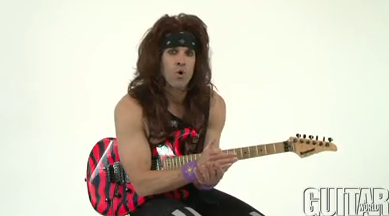Man of Steel with Steel Panther's Satchel: Triplet Feels, Drop-D Riffing and How to Play “Glory Hole”

Hey kids, Satchel here and I’m back (did I leave?) to teach you more great rock riffs from the latest Steel Panther mega-multi-ultra-Platinum release, All You Can Eat. This month, I’d like to focus on the rhythm and lead guitar parts to a tender love song I wrote called “Glory Hole.”
This song is played in drop-D tuning down one half step (low to high, Db Ab Db Gb Bb Eb). Another twist is that the transcribed examples in this column, while written in 4/4, are meant to be played with a triplet feel, which is akin to a 12/8 shuffle-type feel.
This means that each pair of eighth notes is to be played as a quarter note and an eighth note within a triplet bracket. If an eighth-note triplet were to sound “DA-da-da,” or “ONE-trip-let,” the idea is to combine the first two notes to sound a quarter note that sustains through the first two eighth notes of the eighth-note triplet (ONE-trip), followed by the remaining eighth note of the triplet (-let), resulting in a rhythm of “DAAA-da-DAAA-da-DAAA-da-DAAA-da.”
The solo section of “Glory Hole” is 16 bars long, and FIGURE 1 illustrates the rhythm part behind it. The section is basically in the key of D major, though I do take some liberties and play a bit outside the key center in order to create a little bit of a “twisted” feel.
The rhythm part begins with a B5 power chord fretted on the fifth and fourth strings. Playing this chord in this position allows me to repeatedly pull off from B at the second fret of the fifth string to the open A note. Also, when tuned to drop-D, I can easily play three-string power chords by barring a single fret-hand finger across the bottom three strings at any given fret, as I do for the F5 and G5 power chords, as well as sound the D5 power chord by simply strumming the open bottom three strings.
There is a “relative minor/major” axis during the solo section (see FIGURE 2), as I alternate between the chords B5, the relative minor, and D, the relative major. The twist is provided by using a combination of B minor pentatonic (B D E F# A) and D minor pentatonic (D F G A C) over the B5 chord, with the F notes bent up a half step to F#, the major third, over D.
Note also the tremolo picking technique used in bar 13 of the solo, as well as the crazy symmetrical lick, based on the D blues scale (D F G Ab A C) that moves from bar 15 into bar 16. Though written as quintuplets (groups of five notes per beat), I simply think of this as trying to “cram too much stuff into a small space”…which seems appropriate for a song called, “Glory Hole.” See you next month!


Get The Pick Newsletter
All the latest guitar news, interviews, lessons, reviews, deals and more, direct to your inbox!
